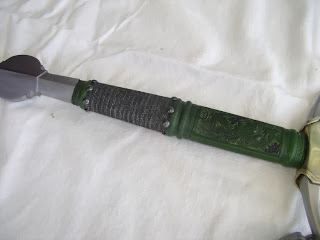Thursday, 16 January 2014
Raw steel
Running a bit low on good quality raw steel bloom. While it's Summer I'll have to smelt a fresh batch within the next two weeks. These are the last remaining bits, probably enough for an Iron age piled construction dagger blade. That or a traditional nGuni spear.
Wednesday, 15 January 2014
Complex hilted longsword
Here is the longsword in progress. The blade is hollow ground and 10mm thick at the base. Nothing about this project is simple to polish.
Here can be seen how far a bar of steel can be stretched during forging. The blank is identical to the one from which the blade was forged.
Polishing, artificial and natural
I use sanding paper for a lot of the finishing work but I found that water stones can ease a lot of the otherwise tedious steps like evening out a fuller or hollow grind. Some are used before sanding while defining shape while others are good for the final polish after sanding. Some of the resultant slurries are used right at the end, mixed with a thick oil to round off the final polish. Here are some of those I have collected at my favourite spots.
Making a complex hilt.
Here are some of the steps used in constructing a complex hilt. If you have a background in traditional blacksmithing it will be relatively simple. Also bear in mind that the actual alloy content of the steel will have an effect on the whole process. The closer to a pure carbon steel or iron, the easier it will weld.
Now it's all about bending and shaping the guard. The contact points are brought in as snug as possible and the fact that both surfaces to be joined are convex will help squirt flux out as they are forged together.
Now for the filing and polishing. This is where sourcing your own water stones comes in handy, especially for those nasty tight corners and hard to reach spaces.
The best I have used for years come from the Cederberg mountain.
The components are forged individually and the end thickened and tapered (scarfed). This will allow you to tap the pieces together at welding heat and blend them as far as needed without worrying about the component thinning too much.
The fit of the loop guard is tested untill it leaves no gaps when in the proper position. When working with such fine pieces you only need to tap the contacting surfaces together, hit too hard and you will end up shearing off the weld or just causing unwanted deformation. The hammer in the foreground is one I made for this kind hilt work. The long faces allow me to get into those awkward spots when doing the last of the welds.
The pieces are brought up to welding heat and fluxed with anhydrous borax. I find it convenient to place the pieces in position while in the forge as soon as they are both at welding heat and then press them together with the appropriate tongs to create the innitial weld that will hold them together. Then I move them out of the forge to finish up the weld. This means that the flux is not exposed to the oxygen rich environment outside of the forge for too long and thus won't get saturated as you work. To be safe I tend to reheat the joint to welding heat at least once more to a consolidate the weld, perhaps twice more if I'm a bit paranoid. It is very important to give the forge just enough air to weld an nothing more, otherwise you will burn steel away everytime you weld, making repeated heats impossible without messing up your workpiece.Now it's all about bending and shaping the guard. The contact points are brought in as snug as possible and the fact that both surfaces to be joined are convex will help squirt flux out as they are forged together.
Now for the filing and polishing. This is where sourcing your own water stones comes in handy, especially for those nasty tight corners and hard to reach spaces.
The best I have used for years come from the Cederberg mountain.
Tuesday, 14 January 2014
Odd, but very functional.
This is a sword I am planning on giving a go. It might not be everyone's cup of tea, but might appeal to some Fiore followers. Still have a few other projects running before I can get to that though.
Friday, 3 January 2014
Subscribe to:
Posts (Atom)
















